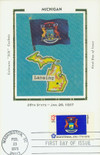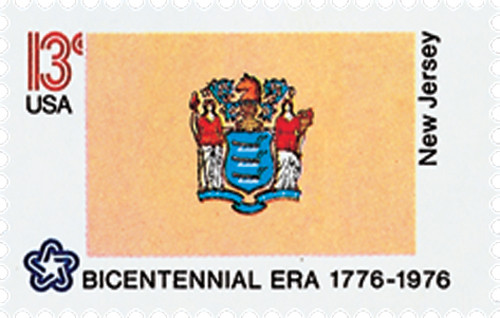
# 1658 - 1976 13c State Flags: Michigan
U.S. 1658
1976 Michigan
State Flags
American Bicentennial Series
• First time a sheet 50 had all different stamp designs
• Part of the American Bicentennial Series
Stamp Category: Commemorative
Series: American Bicentennial Series
Value: 13¢ First-class postage rate
First Day of Issue: February 23, 1976
First Day City(s): Washington, DC
Quantity Issued: 8,720,100 (panes of 50)
Printed by: Bureau of Engraving and Printing
Printing Method: Photogravure
Format: Sheet of 50
Perforations: 11
Why the stamp was issued:
The United States Postal Service celebrated the American Bicentennial with a full pane of the Union’s fifty state flags.
About the stamp design:
The present flag was adopted in 1911 and is the third state flag. It consists of a royal blue field featuring a blue shield with a sun rising over a lake and peninsula. A man is standing with a raised hand to depict peace and the fight for state and nation. The shield is being held by an elk and moose. An eagle is over the shield with a red ribbon above that says “E Pluribus Unum” which means “Out of Many, one.” The shield says Tuebor which translates to “I will defend.” The last Latin motto is under the shield on a white ribbon and says, “Si Quæris Peninsulam Amœnam Circumspice” and translates to “If you seek a pleasant peninsula, look about you.”
About the printing process:
Printed by the Bureau of Engraving and Printing on their seven-color Andreotti gravure press (601) which was their work horse for multicolored stamps.
About the American Bicentennial Series:
In the 1970s, America celebrated its 200th anniversary with hundreds of national events commemorating the heroes and historic events that led to our nation’s independence from Great Britain. The U.S. Postal Service issued 113 commemorative stamps over a six-year period in honor of the U.S. bicentennial, beginning with the American Revolution Bicentennial Commission Emblem stamp (U.S. #1432). As a group, the Bicentennial Series chronicles one of our nation’s most important chapters, and remembers the events and patriots who made the U.S. a world model for liberty.
Several of the stamps honored colonial life – craftsmen and communication. Other stamps honored important battles including Lexington and Concord, Bunker Hill, and Saratoga. Significant events such as the Boston Tea Party, the meeting of the First Continental Congress, and the Declaration of Independence were featured as well. The stamps also honored many significant people such as George Washington, Sybil Ludington, Salem Poor, and the Marquis de Lafayette.
Many of the stamps feature classic artwork. For instance, the set of four souvenir sheets picture important events recreated by noted artists such as John Trumbull. The Bicentennial Series also includes an important US postal first – the first 50-stamp se-tenant – featuring all 50 state flags. The format proved to be popular with collectors, and has been repeated many times since.
The American Bicentennial Series is packed with important US history – it tells the story of our nation’s fight for independence through stamps.
History the stamp represents:
On January 26, 1837, President Andrew Jackson approved Michigan’s bid for statehood.
French explorer Étienne Brûlé was likely the first European to visit Michigan when he explored the area around 1620. In 1634, Quebec Governor Samuel de Champlain sent Jean Nicolet to search for a route to the Pacific Ocean. Nicolet sailed through the Straits of Mackinac and explored the Upper Peninsula. In 1660, Father René Ménard established a Jesuit mission at Keweenaw Bay. The first permanent settlement was created by Father Jacques Marquette at Sault Ste. Marie in 1668.
France and Great Britain struggled for control of North America during the late 1600s and 1700s. By 1763, France was defeated and forced to relinquish control of most of its North American colonies. That same year, the Ottawa Indian Chief Pontiac led an uprising and massacred the British at Fort Michilimackinac and attacked several other forts. Pontiac’s forces laid siege to Detroit for five months, but were eventually turned away. In 1774, the British made Michigan a part of the province of Quebec.
After the Revolutionary War ended in 1783, America gained the Michigan area. However, the British kept control of Detroit and Fort Mackinac until 1796, to control the valuable fur trade. In 1787, Michigan became part of the first territory organized by the U.S. government, the Northwest Territory. A section of Michigan was organized as part of the Indiana Territory in 1800, and by 1803, all of Michigan was in the Indiana Territory. In 1805, Congress created the Territory of Michigan, which included the Lower Peninsula and the eastern portion of the Upper Peninsula. The British reclaimed Detroit and Fort Mackinac during the War of 1812. American forces took Detroit in 1813, but Fort Mackinac remained in British hands until 1814, after the war had ended. Many new settlers from the East came to Michigan when the Erie Canal was completed in 1825.
A constitutional convention was held, and on October 5, 1835, the people ratified the state’s constitution. However, Congress delayed Michigan’s admittance to the Union due to a dispute with Ohio over the Toledo area. Congress settled this in 1836 by giving the “Toledo Strip” to Ohio and the entire Upper Peninsula to Michigan. Finally, Michigan became the 26th state to join the Union on January 26, 1837.
U.S. 1658
1976 Michigan
State Flags
American Bicentennial Series
• First time a sheet 50 had all different stamp designs
• Part of the American Bicentennial Series
Stamp Category: Commemorative
Series: American Bicentennial Series
Value: 13¢ First-class postage rate
First Day of Issue: February 23, 1976
First Day City(s): Washington, DC
Quantity Issued: 8,720,100 (panes of 50)
Printed by: Bureau of Engraving and Printing
Printing Method: Photogravure
Format: Sheet of 50
Perforations: 11
Why the stamp was issued:
The United States Postal Service celebrated the American Bicentennial with a full pane of the Union’s fifty state flags.
About the stamp design:
The present flag was adopted in 1911 and is the third state flag. It consists of a royal blue field featuring a blue shield with a sun rising over a lake and peninsula. A man is standing with a raised hand to depict peace and the fight for state and nation. The shield is being held by an elk and moose. An eagle is over the shield with a red ribbon above that says “E Pluribus Unum” which means “Out of Many, one.” The shield says Tuebor which translates to “I will defend.” The last Latin motto is under the shield on a white ribbon and says, “Si Quæris Peninsulam Amœnam Circumspice” and translates to “If you seek a pleasant peninsula, look about you.”
About the printing process:
Printed by the Bureau of Engraving and Printing on their seven-color Andreotti gravure press (601) which was their work horse for multicolored stamps.
About the American Bicentennial Series:
In the 1970s, America celebrated its 200th anniversary with hundreds of national events commemorating the heroes and historic events that led to our nation’s independence from Great Britain. The U.S. Postal Service issued 113 commemorative stamps over a six-year period in honor of the U.S. bicentennial, beginning with the American Revolution Bicentennial Commission Emblem stamp (U.S. #1432). As a group, the Bicentennial Series chronicles one of our nation’s most important chapters, and remembers the events and patriots who made the U.S. a world model for liberty.
Several of the stamps honored colonial life – craftsmen and communication. Other stamps honored important battles including Lexington and Concord, Bunker Hill, and Saratoga. Significant events such as the Boston Tea Party, the meeting of the First Continental Congress, and the Declaration of Independence were featured as well. The stamps also honored many significant people such as George Washington, Sybil Ludington, Salem Poor, and the Marquis de Lafayette.
Many of the stamps feature classic artwork. For instance, the set of four souvenir sheets picture important events recreated by noted artists such as John Trumbull. The Bicentennial Series also includes an important US postal first – the first 50-stamp se-tenant – featuring all 50 state flags. The format proved to be popular with collectors, and has been repeated many times since.
The American Bicentennial Series is packed with important US history – it tells the story of our nation’s fight for independence through stamps.
History the stamp represents:
On January 26, 1837, President Andrew Jackson approved Michigan’s bid for statehood.
French explorer Étienne Brûlé was likely the first European to visit Michigan when he explored the area around 1620. In 1634, Quebec Governor Samuel de Champlain sent Jean Nicolet to search for a route to the Pacific Ocean. Nicolet sailed through the Straits of Mackinac and explored the Upper Peninsula. In 1660, Father René Ménard established a Jesuit mission at Keweenaw Bay. The first permanent settlement was created by Father Jacques Marquette at Sault Ste. Marie in 1668.
France and Great Britain struggled for control of North America during the late 1600s and 1700s. By 1763, France was defeated and forced to relinquish control of most of its North American colonies. That same year, the Ottawa Indian Chief Pontiac led an uprising and massacred the British at Fort Michilimackinac and attacked several other forts. Pontiac’s forces laid siege to Detroit for five months, but were eventually turned away. In 1774, the British made Michigan a part of the province of Quebec.
After the Revolutionary War ended in 1783, America gained the Michigan area. However, the British kept control of Detroit and Fort Mackinac until 1796, to control the valuable fur trade. In 1787, Michigan became part of the first territory organized by the U.S. government, the Northwest Territory. A section of Michigan was organized as part of the Indiana Territory in 1800, and by 1803, all of Michigan was in the Indiana Territory. In 1805, Congress created the Territory of Michigan, which included the Lower Peninsula and the eastern portion of the Upper Peninsula. The British reclaimed Detroit and Fort Mackinac during the War of 1812. American forces took Detroit in 1813, but Fort Mackinac remained in British hands until 1814, after the war had ended. Many new settlers from the East came to Michigan when the Erie Canal was completed in 1825.
A constitutional convention was held, and on October 5, 1835, the people ratified the state’s constitution. However, Congress delayed Michigan’s admittance to the Union due to a dispute with Ohio over the Toledo area. Congress settled this in 1836 by giving the “Toledo Strip” to Ohio and the entire Upper Peninsula to Michigan. Finally, Michigan became the 26th state to join the Union on January 26, 1837.


















